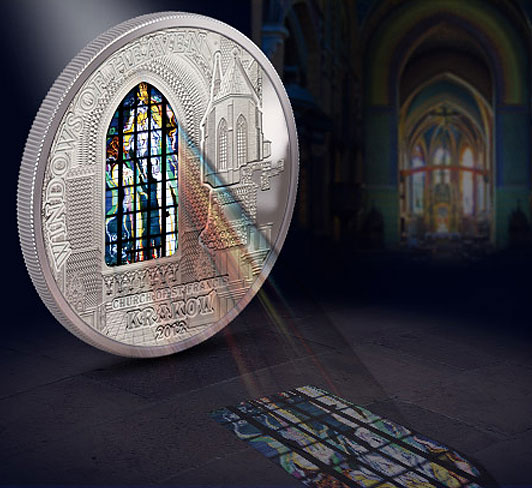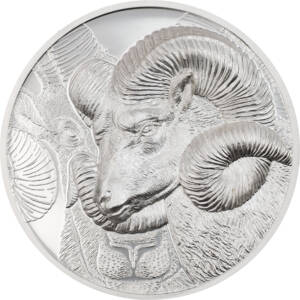
.
A stunning new series of silver coins minted for the Cook Islands pays tribute to famous Cathedrals throughout the world. Beautifully designed, featuring stained glass windows, the series bears the title “The Windows of Heaven”.
The obverse of the coin represents an effigy of Elizabeth II as well as the inscription of the Queen’s name. There is a full-colour window ins ert next to the portrait. The obverse also contains the legends indicating the face value of the coin and the name of the issuing country.
The reverse design features the image of the magnificent Church of St. Francis in Krakow, with a plan of the outlay of the cathedral below. Being a powerful testimony to the strength and persistence of Christian belief in medieval and modern Europe, the temple has an exceptional intrinsic val ue and contains artistic masterpieces, one of them reflected in a full-colour window insert on the reverse of this silver coin. The upper part of the coin contains the legend denoting the name of the series. Below the images, there are the inscriptions of the name of the city and the year of mintage.
Special Features:
-
Contains 50 grams of .925 Silver.
-
Coin is decorated with real stained glass
-
Each coin comes in a special box with a COA.
-
Strict limited mintage of only 2000 coins.
-
Obverse: Effigy of Queen Elizabeth II, “Cook Islands”, and the legal tender value of 10 Dollars
-
Reverse: A very high quality rendition of Church of St. Francis in Krakow
In the series of Windows of Heaven you can find:
2010 Windows of Heaven – Cologne
2011 Windows of Heaven – Notre Dame de Paris
2011 Windows of Heaven – Sevilla
2011 Windows of Heaven – Westminster Abbey London
2011 Windows of History – Titanic
2012 Windows of Heaven – Bethlehem
2012 Windows of Heaven – Cracow St Francis
2012 Windows of Heaven – St Isaac Cathedral
2013 Windows of Heaven – Chartres
2013 Windows of Heaven – Lourdes
2013 Windows of Heaven – Milan Cathedral
2013 Windows of History – Grand Central Terminal
2014 Windows of Heaven – Buenos Aires
2014 Windows of Heaven – Sacre Coeur
2014 Windows of Heaven – Washington National Cathedral – Special Editon
2014 Windows of Heaven Giants – Cologne Cathedral – Special Edition
2015 Windows of Heaven – Zagreb Cathedral
2015 Windows of Heaven – Stockholm
2015 Windows of Heaven – Jerusalem Dominus Flevit
2015 Windows of Heaven Giants – Notre Dame – Special Edition
History:
The Church of St. Francis of Assisi with Monastery of the Franciscan Order (Polish: Kościół św. Franciszka z Asyżu) located in the Old Town district of Kraków, Poland, is a Roman Catholic religious complex on the west side of the All Saints Square at ul. Franciszkańska 2, across the street from the Bishop’s Palace – residence of Pope John Paul II during his stays in the city. The Church dates back to the 13th century. Saint Maximilian Kolbe was a monk there in 1919, and led his first service at this church on Poland’s return to sovereignty.
There is no consensus among historians about the church’s founder. He was probably Duke Henry II the Pious (1196–1241), son of Prince Henry the Bearded (1165–1238) who resided in Kraków and also previously invited the Franciscans to Wrocław. His wife, Anna (daughter of the Bohemian King Premysl Otakar I), and especially her sister Agnes (Agnieszka) contributed as well. However, widely regarded as the founder is also Duke Bolesław V the Chaste with his wife St. Kinga, especially in the construction and reconstruction of the church and monastery after the devastation of the Mongol invasion in 1241.
The Church was one of the first tall brick-and-sandstone buildings in the city. The original 13th-century Gothic structure was consecrated before 1269, and expanded in 1260–70. Not much remains from that particular period other than the ribbed 13th-century vault. Presbytery was elongated beginning in 1401 with the three-sided apsis (pictured). The cross-shaped central part with nave arcades was added around 1420–36 (the original chancel was straight). The annexes gave the temple a shape of a Greek cross for the first time. The expansion was re-consecrated by Cardinal Zbigniew Oleśnicki in 1436. In spite of various calamities (1462, 1476, 1655), the Church of St. Francis of Assisi and the adjacent Monastery experienced the most destructive fire only in 1850. The written records of its consecration along with priceless artifacts were lost.
For the Franciscan Order in Poland the period of foreign partitions was deadly. By 1864, from over 90 Franciscan monasteries only 8 remained in the country including the one in Kraków. The situation slightly improved after the Austro-Prussian War. In 1866, Austria granted a degree of autonomy to Kraków after its own massive defeat. In 1895, the eastern part of the church received murals with floral motifs by the founder of Young Poland, Stanisław Wyspiański. Wyspiański was also the author of magnificent stained glass windows in the apse, manufactured at the Innsbruck foundry in 1899–1904. The re-consecration of the renovated church by Bishop of Kraków, Anatol Nowak, took place on 14 June 1908. It was promoted to the rank of Basilica Minor on 23 February 1920.

Church of St. Francis in Krakow













